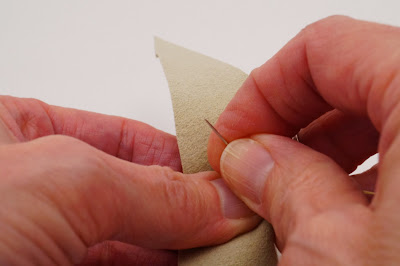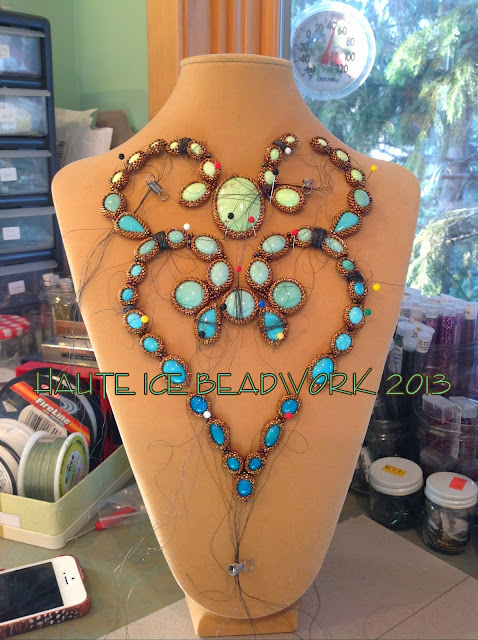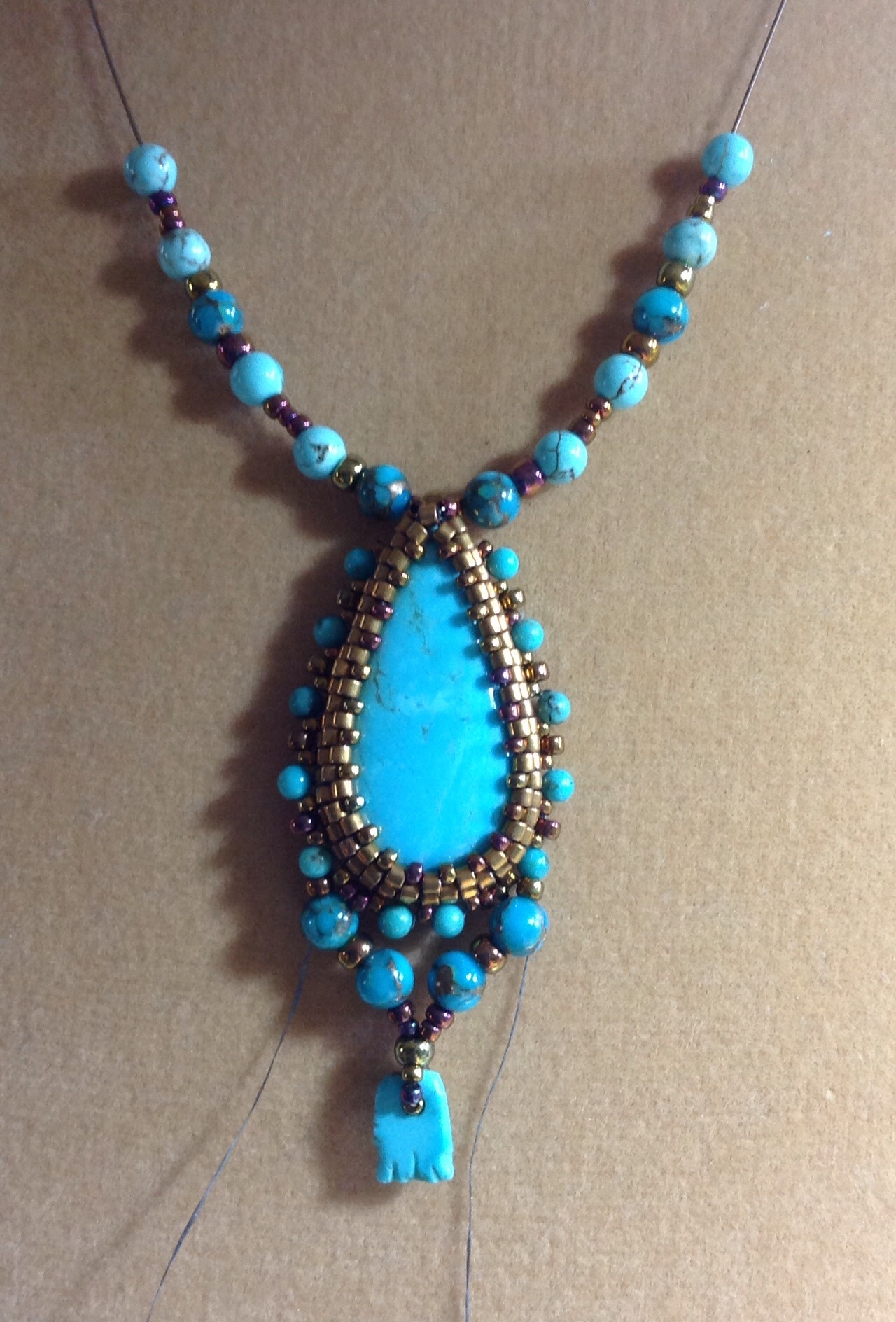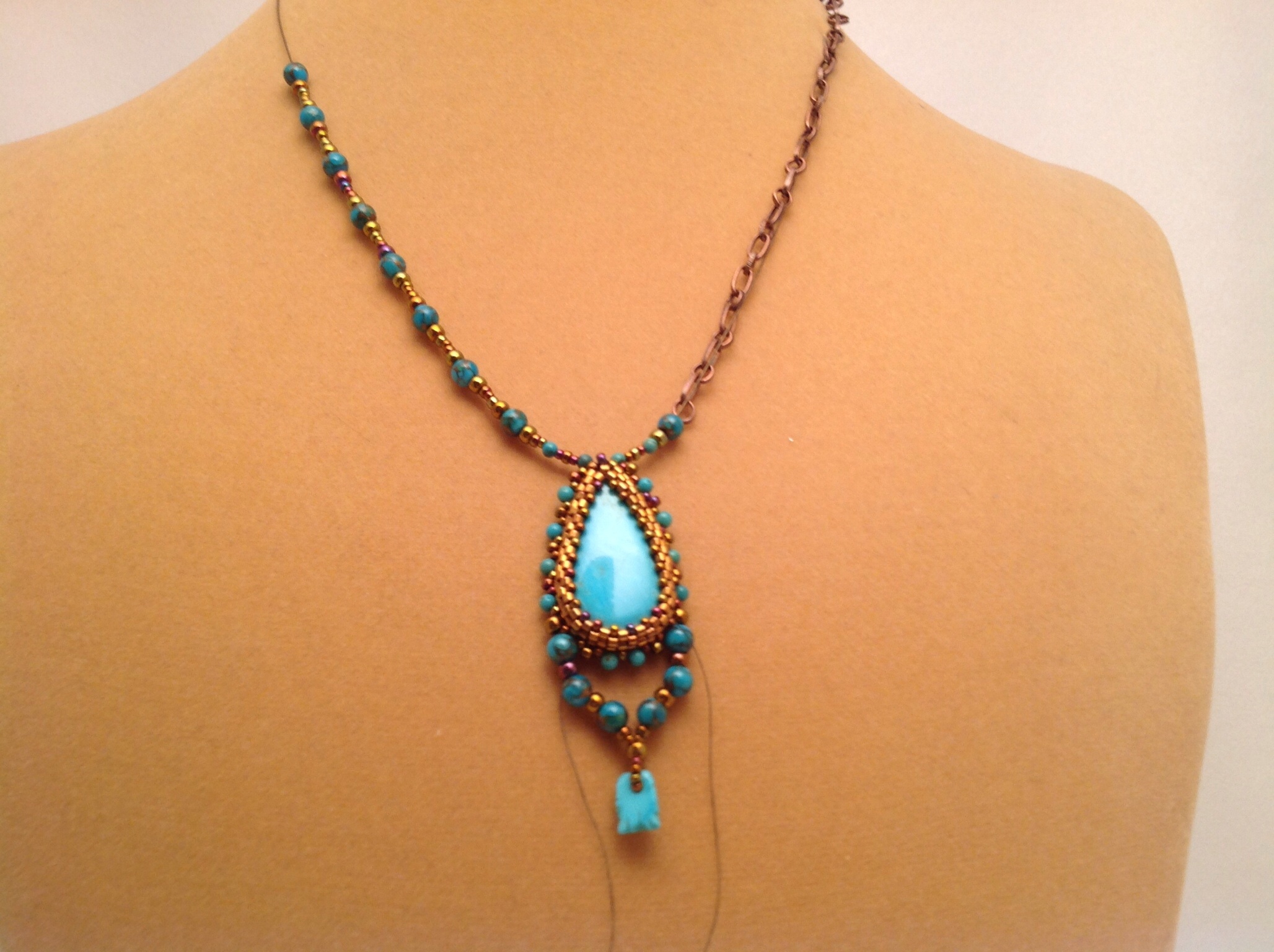I am never very successful when I set out to create something that I imagine other people might like to make. All around me, my beady friends are creating tutorials for their designs and selling them. I am torn by this. I have very little time available to spend with beads, given I have a demanding full time job. I really enjoy the design and engineering aspects of beadweaving. I want to maximize my time with those things. But I also feel selfish for not sharing my ideas. So every so often, I take a little stab at designing something that I think might be a decent tutorial.

Usually, I ask myself, what do I do that I see others either NOT doing, or struggling with. I am a very competent bezeler. And I can manage any shape, scale, and proportion with relative ease. So I decided I would bezel a popular and recent cab, a lunasoft, in a shape that people seem to struggle with, and create something from it.
I owned some of these, purchased from my friend Doris Coghill, in a lovely ocean blue and since the Etsy Beadweavers theme for August was "Ocean Adventures" is seemed a good fit.
As I worked out the bezel bead counts and decreases I took pictures. I thought that the tutorial might include general informaton about how to create bezels for geometrtic shapes as well as this particular one. So... generally,
NUMBERS MATTER, when creating bezels.
Your base row must be an even number. And some numbers are just better than others, like any number with multiple even divisiors, like for example, 24 (12, 6, 3) is better than any even number that can only be evenly divided once, before an odd number appears, like 30 (15). This is because bezels look best if they are balanced side to side. On a round bezel, this is less important, and ovals can be cheated as well, but to get to the point, geometric shapes demand even base row numbers that are divisible by the number of sides of the shape.
So my choices for base row numbers for any square must be divisible by four.
I strung delicas until I had about the right number of delica beads to encircle my lunasoft cab. In this particular case, I wanted to create a color shift in my bezel, so I alternated a dark (1285) and lighter blue (0863) bead. Then, I hunted for the perfect number. The number of beads has to be divisible by 4, and the ring of beads cannot be loose on the cab. Your base row can be a little too tight, or a little too loose. For me, the perfect number in this case was 64. It divided SO nicely! 64, 32, 16, 8, 4, 2. 64 is one of the magical numbers in bezel beading! And it was just a tiny bit too tight, when pulled up snugly, to fit entirely around my cabochon. Lucky me! My Lunasoft cab is 20x20mm, so this magic number 64 would work beautifully for any cab that size as a base row. I will later enlarge it at the corners enough to fit.

When I bezel, I start differently, depending on my purpose. In this case, I wanted the front of the bezel to create a white cap effect, so I worked the front of the cab first. I strung my beads on a 60" length of fireline, waxed my thread to help with the first row tension, and stitched through the first bead again. Then I clamped the thread about an inch past the ring of beads. Holding the beads flat on my fingers, and in place with my thumb, I began to peyote stitch the first row on the outside of the ring, with the dark blue.

I keep the clamp under my hand, out of the way of the thread, like this. The weight of the clamp, and my fingers held together keep my tension snug on the first row of peyote, but this works best of you have waxed with either beeswax, or microcrystaline wax, to improve grip. I think of shaping the beads as I go, in to the shape I am trying to create, so when I was done with this step, I had a rough, rounded looking square.
Then I stepped up into the middle row, and again into the center of the rounded square of beads. Notice I am in the middle of a side here. I think that is much easier than starting at a corner.
Since I have 4 sides, and my magical 64 beads divide by 4 into four sides of 16 base row beads, I know that I would have eight delica beads on each side of my square. But now it is time to begin shaping my square more precisely. So instead of stitching 8 delicas on each side, I will only stitch seven, and skip a bead at each corner, pulling the corner into a neat right angle.

I stitched three light blue delicas, added a lighter blue satin delica and then took a stitch without adding a bead when I got to my intended corner. In this picture, I have put my satin bead on and taken a stitch and then taken a second stitch, without a bead. Could have been a clearer picture had I done each step separately. :) I did the color switch in the interest of my white caps, but if you are just wanting the nice square bezel, no need to change colors. Snug up your corner before proceeding.

Then for my next side, I stitched one satin delica, five light blue delicas, one more satin delica, The seven beads for the side, and skipped adding a bead on the 8th stitch again. I repeated this until I got back to my starting point, and my square was complete. Each side has 7 delicas, one satin, 5 light blue, and one satin, and a stitch without a bead.
So here is the finished square, wiht my needle demonstrating the step up into the next row of peyote bezel.

In my next row, I stitched two light blue satin delicas, one pearl white delica, and a 15/0 white pearl rocaille at the corner. As you continue around the bezel, each row in this round will have a white pearl delica, four satin delicas, a white pearl delica, and a 15/0 pearl rocaille in the corner. This could be a stopping point for a nice square bezel, and you might also be able to use 15/0 rocailles in each stitch, but keep your tension relaxed if you do not want your bezel to tighten excessively.

In my particular bezel, in the next row, we will decrease again, and we will also begin adding our white seafoam droplets. So we will peyote stitch two satin delicas, one white pearl delica, and at the corner, stitch in a small white pearl drop bead. Each repeating row in this round will have a white pearl delica, three light blue satin delicas, a white pearl delica and a small drop at the corner.

The next row is a little trickier, because it includes a step down into the previous row at the corners. Begin by stepping up into the new row, and stitching one white pearl delica, and one small pearl drop. Then step down into the previous row and move into the next side through the corner pearl drop, and step back up into the new row. Each row in this round will contain the step up you just did, a small white pearl drop, two white pearl delicas, a small white pearl drop and the step down into the previous row to pass the corner.
With the last side of this round finished, your bezel looks like this:

Now for the final row, which also includes a corner step down, this time through two rows. Step up into the white delica, and add a three 15/0 pearl bead picot, which you should push out, over the finished portion of the bezel. Step down two rows and pass the corner through the first small pearl drop again, and step back up two rows and add another picot, pushed out, and a large pearl drop, laying in over the top of the bezel, followed by another pushed out picot, and a step down, the process repeating to finish the final row of the bezel. Here you see me stepping down to the outside edge of the bezel, and most of the picots and drops are sitting where they should be, but you must align them correctly when you are done. There is only room for them to sit where they should, but you have to show them where that is. I have not correctly oriented the last side of the last row in this picture. As you step past the original thread tail, make sure it stays on the outside of the beadwork, so you can stitch it back in and trim it off at your convenience.


At the outside row, I added a final dark blue row of delicas, with an 8/0 bead at each corner to create an easy place to attach my components together and drape through them. These 8/0's also enlarge the frame enough to fit the cabochon easily.
After stitching this row, I popped in my cabochon, after painting the back of it with clear nail polish to protect it from wear, and allowing it to completely dry.

Then I turned the thread so I could keep stitching counter-clockwise, as I am right handed and that is my strong preference. I peyote stitched a row of delicas, with 15/0 rocailles at the corners to begin the tightening process and stitched an additional row of delicas to secure the cab. You could continue with additional rows if you liked, but the cab is secure with this row.
I did stitch one final row of 15/0 on one bezel, and two on the other two, which you can see in the image of the finished back of the work.
Now, since this little necklace has been poorly received, I will not continue with the rest of the necklace, and probably, if anyone actually uses this bezel advice, they will stop at the square frame work many steps ago. But the best information is the numeric info, and perhaps, I will show other shapes more simply in future posts.

I personally like this piece, and I think it looks great with denim. I really enjoyed embellishing the bezel centers in my Artichoke! piece, and wanted to explore that idea further here. I think the intense matte blue color is off-putting to some, perhaps. I liked the absence of shine because it made it feel deep to me, like an ocean. And without any metal beads, beadwork looks less like legitimate jewelry. I think my own feelings about the ocean might be off-putting as well. I purposefully threw the squares into tumbling action, because I have terrible motion sickness, and just looking at the ocean makes me feel disoriented and dizzy. I wanted the work to have a horizon line that would shift in wearing, rarely being perfectly horizontal, and it does that really well. :) I liked the fringy tassel for the same reason, and the curved drapes reminded me of waves.
For me, a happy result. For others, not so much, but the great thing about what I do with beads is, in my day job, where there is always a client to be interpreted, flattered, made beautiful, and pleased.
At my beading bench, there is only me.






















































